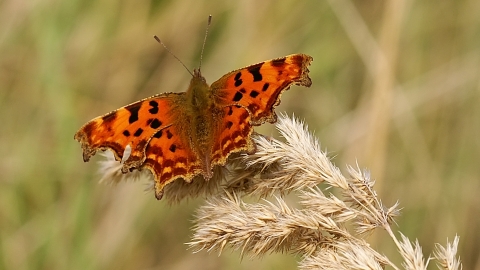
Comma ©David Longshaw
Comma
Enw gwyddonol: Polygonia c-album
The comma has distinctively ragged wing edges, which help to camouflage it - at rest, it looks just like a dead leaf! It prefers woodland edges, but can be spotted feeding on fallen fruit in gardens.
Species information
Category
Ystadegau
Wingspan: 5.0-6.4cmStatws cadwraethol
Common.
Pryd i'w gweld
January to DecemberYnghylch
The comma is a medium-sized orange-and-brown butterfly. It gets its name from the comma-shaped white spots on the underneath of its wings. It is on the wing throughout the year, having several broods and overwintering as an adult. It is a common and widespread butterfly of woodland edges, particularly during the spring and autumn. The caterpillars feed on common nettles, elms and willows.They have brown and white flecks that make them look like bird-droppings and help to camouflage them.
Sut i'w hadnabod
The comma is unmistakeable: ragged, orange wings with brown spots distinguish it from similar species. Its underside has cryptic brown colouring, making it look like a dead leaf.Dosbarthiad
Found across England and Wales, and spreading into southern Scotland.Roeddech chi yn gwybod?
Commas that emerge in early summer are much paler in colour than those that appear later on. This paler form will have a second brood, while the darker form overwinters as an adult.Sut y gall bobl helpu
The Wildlife Trusts manage many woodland nature reserves sympathetically for the benefit of all kinds of butterflies, including the comma. A mix of coppicing, scrub-cutting, ride maintenance and non-intervention all help woodland wildlife to thrive. You can help too: volunteer for your local Wildlife Trust and you could be involved in everything from traditional forest crafts to surveying for butterflies.Gwyliwch
Comma caterpillar and butterfly © Tom Hibbert
